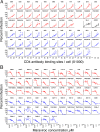Comparison of viral Env proteins from acute and chronic infections with subtype C human immunodeficiency virus type 1 identifies differences in glycosylation and CCR5 utilization and suggests a new strategy for immunogen design
- PMID: 23616655
- PMCID: PMC3700278
- DOI: 10.1128/JVI.03577-12
Comparison of viral Env proteins from acute and chronic infections with subtype C human immunodeficiency virus type 1 identifies differences in glycosylation and CCR5 utilization and suggests a new strategy for immunogen design
Abstract
Understanding human immunodeficiency virus type 1 (HIV-1) transmission is central to developing effective prevention strategies, including a vaccine. We compared phenotypic and genetic variation in HIV-1 env genes from subjects in acute/early infection and subjects with chronic infections in the context of subtype C heterosexual transmission. We found that the transmitted viruses all used CCR5 and required high levels of CD4 to infect target cells, suggesting selection for replication in T cells and not macrophages after transmission. In addition, the transmitted viruses were more likely to use a maraviroc-sensitive conformation of CCR5, perhaps identifying a feature of the target T cell. We confirmed an earlier observation that the transmitted viruses were, on average, modestly underglycosylated relative to the viruses from chronically infected subjects. This difference was most pronounced in comparing the viruses in acutely infected men to those in chronically infected women. These features of the transmitted virus point to selective pressures during the transmission event. We did not observe a consistent difference either in heterologous neutralization sensitivity or in sensitivity to soluble CD4 between the two groups, suggesting similar conformations between viruses from acute and chronic infection. However, the presence or absence of glycosylation sites had differential effects on neutralization sensitivity for different antibodies. We suggest that the occasional absence of glycosylation sites encoded in the conserved regions of env, further reduced in transmitted viruses, could expose specific surface structures on the protein as antibody targets.
Figures





Similar articles
-
Transmitted/founder and chronic subtype C HIV-1 use CD4 and CCR5 receptors with equal efficiency and are not inhibited by blocking the integrin α4β7.PLoS Pathog. 2012;8(5):e1002686. doi: 10.1371/journal.ppat.1002686. Epub 2012 May 31. PLoS Pathog. 2012. PMID: 22693444 Free PMC article.
-
Human immunodeficiency virus type 1 V1-V2 envelope loop sequences expand and add glycosylation sites over the course of infection, and these modifications affect antibody neutralization sensitivity.J Virol. 2006 Oct;80(19):9586-98. doi: 10.1128/JVI.00141-06. J Virol. 2006. PMID: 16973562 Free PMC article.
-
V2 loop glycosylation of the human immunodeficiency virus type 1 SF162 envelope facilitates interaction of this protein with CD4 and CCR5 receptors and protects the virus from neutralization by anti-V3 loop and anti-CD4 binding site antibodies.J Virol. 2000 Aug;74(15):6769-76. doi: 10.1128/jvi.74.15.6769-6776.2000. J Virol. 2000. PMID: 10888615 Free PMC article.
-
HIV-1 subtype C predicted co-receptor tropism in Africa: an individual sequence level meta-analysis.AIDS Res Ther. 2020 Feb 7;17(1):5. doi: 10.1186/s12981-020-0263-x. AIDS Res Ther. 2020. PMID: 32033571 Free PMC article. Review.
-
HIV-1 envelope, integrins and co-receptor use in mucosal transmission of HIV.J Transl Med. 2011 Jan 27;9 Suppl 1(Suppl 1):S2. doi: 10.1186/1479-5876-9-S1-S2. J Transl Med. 2011. PMID: 21284901 Free PMC article. Review.
Cited by
-
Compartmentalized replication of R5 T cell-tropic HIV-1 in the central nervous system early in the course of infection.PLoS Pathog. 2015 Mar 26;11(3):e1004720. doi: 10.1371/journal.ppat.1004720. eCollection 2015 Mar. PLoS Pathog. 2015. PMID: 25811757 Free PMC article. Clinical Trial.
-
Generation and characterization of infectious molecular clones of transmitted/founder HIV-1 subtype C viruses.Virology. 2023 Jun;583:14-26. doi: 10.1016/j.virol.2023.04.001. Epub 2023 Apr 10. Virology. 2023. PMID: 37084644 Free PMC article.
-
Delineating CD4 dependency of HIV-1: Adaptation to infect low level CD4 expressing target cells widens cellular tropism but severely impacts on envelope functionality.PLoS Pathog. 2017 Mar 6;13(3):e1006255. doi: 10.1371/journal.ppat.1006255. eCollection 2017 Mar. PLoS Pathog. 2017. PMID: 28264054 Free PMC article.
-
Compartmentalization, Viral Evolution, and Viral Latency of HIV in the CNS.Curr HIV/AIDS Rep. 2015 Jun;12(2):262-71. doi: 10.1007/s11904-015-0265-9. Curr HIV/AIDS Rep. 2015. PMID: 25914150 Free PMC article. Review.
-
Identification, molecular cloning, and analysis of full-length hepatitis C virus transmitted/founder genotypes 1, 3, and 4.mBio. 2015 Feb 24;6(2):e02518. doi: 10.1128/mBio.02518-14. mBio. 2015. PMID: 25714714 Free PMC article.
References
-
- Shaw GM, Hunter E. 2012. HIV transmission, p 135–157 In Bushman FD, Nabel GJ, Swanstrom R. (ed), HIV: from biology to prevention and treatment. Cold Spring Harbor Laboratory Press, Cold Spring Harbor, NY
-
- Abrahams MR, Anderson JA, Giorgi EE, Seoighe C, Mlisana K, Ping LH, Athreya GS, Treurnicht FK, Keele BF, Wood N, Salazar-Gonzalez JF, Bhattacharya T, Chu H, Hoffman I, Galvin S, Mapanje C, Kazembe P, Thebus R, Fiscus S, Hide W, Cohen MS, Karim SA, Haynes BF, Shaw GM, Hahn BH, Korber BT, Swanstrom R, Williamson C. 2009. Quantitating the multiplicity of infection with human immunodeficiency virus type 1 subtype C reveals a non-Poisson distribution of transmitted variants. J. Virol. 83:3556–3567 - PMC - PubMed
-
- Derdeyn CA, Decker JM, Bibollet-Ruche F, Mokili JL, Muldoon M, Denham SA, Heil ML, Kasolo F, Musonda R, Hahn BH, Shaw GM, Korber BT, Allen S, Hunter E. 2004. Envelope-constrained neutralization-sensitive HIV-1 after heterosexual transmission. Science 303:2019–2022 - PubMed
-
- Fischer W, Ganusov VV, Giorgi EE, Hraber PT, Keele BF, Leitner T, Han CS, Gleasner CD, Green L, Lo CC, Nag A, Wallstrom TC, Wang S, McMichael AJ, Haynes BF, Hahn BH, Perelson AS, Borrow P, Shaw GM, Bhattacharya T, Korber BT. 2010. Transmission of single HIV-1 genomes and dynamics of early immune escape revealed by ultra-deep sequencing. PLoS One 5:e12303.10.1371/journal.pone.0012303 - DOI - PMC - PubMed
Publication types
MeSH terms
Substances
Grants and funding
LinkOut - more resources
Full Text Sources
Other Literature Sources
Medical
Molecular Biology Databases
Research Materials

